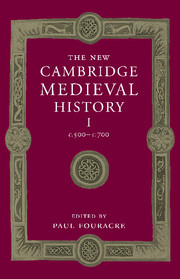Book contents
- Frontmatter
- Introduction: the history of Europe 500–700
- 1 The later Roman Empire
- 2 The Barbarian invasions
- 3 The sources and their interpretation
- PART I THE SIXTH CENTURY
- PART II THE SEVENTH CENTURY
- 11 The Byzantine empire in the seventh century
- 12 Muhammad and the rise of Islam
- 13 The Catholic Visigothic kingdom
- 14 Francia in the seventh century
- 15 Religion and society in Ireland
- 16 Christianity amongst the Britons, Dalriadan Irish and Picts
- 17 England in the seventh century
- 18 Scandinavia
- 19 The Slavs
- PART III THEMES AND PROBLEMS
- List of Primary sources
- Bibliography of secondary works arranged by chapter
- Index
- Frontispiece"
- Plate section"
- Map 3 Gaul/Francia in the sixth and seventh centuries"
- References
14 - Francia in the seventh century
from PART II - THE SEVENTH CENTURY
Published online by Cambridge University Press: 28 March 2008
- Frontmatter
- Introduction: the history of Europe 500–700
- 1 The later Roman Empire
- 2 The Barbarian invasions
- 3 The sources and their interpretation
- PART I THE SIXTH CENTURY
- PART II THE SEVENTH CENTURY
- 11 The Byzantine empire in the seventh century
- 12 Muhammad and the rise of Islam
- 13 The Catholic Visigothic kingdom
- 14 Francia in the seventh century
- 15 Religion and society in Ireland
- 16 Christianity amongst the Britons, Dalriadan Irish and Picts
- 17 England in the seventh century
- 18 Scandinavia
- 19 The Slavs
- PART III THEMES AND PROBLEMS
- List of Primary sources
- Bibliography of secondary works arranged by chapter
- Index
- Frontispiece"
- Plate section"
- Map 3 Gaul/Francia in the sixth and seventh centuries"
- References
Summary
The main focus of the narrative history of Francia in the seventh century is its ruling dynasty, the Merovingians. This is because the precious few Franks who commented upon what was happening around them were primarily interested in a tiny social elite which participated in the exercise of power through the medium of the royal palace. Hardly less for modern commentators, the doings of kings, and of queens, and the arrangement of power in and out of the palace, have become the necessary principles around which we must organise our understanding of events. The very chronology of the period is determined according to which king ruled where, and for how long. The Merovingians themselves have a poor reputation – they are notorious as ‘the do-nothing kings’ – and given the nature of our sources, this has had the effect of dragging the seventh century down with them. In the most pessimistic view, its main redeeming feature was that it also saw the rise of the family which would form a new ruling dynasty, namely the Carolingians. The ‘decline of the Merovingians and the rise of the Carolingians’ has thus often been the keynote for studies of seventh-century Francia. But the beginning of the transition from the one dynasty to the other is by no means the most significant feature of seventh-century history. Far more important is that this period saw the maturing of a political culture that would outlast both Merovingians and Carolingians and spread well beyond Francia itself. With a gradual disappearance of direct taxation and with the enlargement of territory under a single ruler, the seventh century saw the development of a regime which was formed out of consensus between the different groups of the powerful in society.
Keywords
- Type
- Chapter
- Information
- The New Cambridge Medieval History , pp. 371 - 396Publisher: Cambridge University PressPrint publication year: 2005
References
- 3
- Cited by



